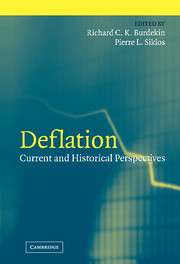Book contents
- Frontmatter
- Contents
- List of Tables and Figures
- List of Contributors
- Preface
- 1 Fears of Deflation and the Role of Monetary Policy: Some Lessons and an Overview
- PART ONE FEARS OF DEFLATION AND THE ROLE OF MONETARY POLICY
- PART TWO DEFLATION AND ASSET PRICES
- 5 Boom–Busts in Asset Prices, Economic Instability, and Monetary Policy
- 6 Deflation, Credit, and Asset Prices
- PART THREE INTERNATIONAL PERSPECTIVES ON DEFLATION
- PART FOUR STOCK MARKET ADJUSTMENTS TO DEFLATION
- References
- Index
- Titles in the series
6 - Deflation, Credit, and Asset Prices
Published online by Cambridge University Press: 15 December 2009
- Frontmatter
- Contents
- List of Tables and Figures
- List of Contributors
- Preface
- 1 Fears of Deflation and the Role of Monetary Policy: Some Lessons and an Overview
- PART ONE FEARS OF DEFLATION AND THE ROLE OF MONETARY POLICY
- PART TWO DEFLATION AND ASSET PRICES
- 5 Boom–Busts in Asset Prices, Economic Instability, and Monetary Policy
- 6 Deflation, Credit, and Asset Prices
- PART THREE INTERNATIONAL PERSPECTIVES ON DEFLATION
- PART FOUR STOCK MARKET ADJUSTMENTS TO DEFLATION
- References
- Index
- Titles in the series
Summary
INTRODUCTION
Over the last two decades, most industrialised and developing countries have experienced episodes of boom and bust in credit markets. These credit cycles often coincided with cycles in economic activity and asset prices. The unwinding of the imbalances built up in the boom has, in some cases, led to severe problems in the financial sector, sometimes culminating in an outright banking crisis. In Japan, the second biggest economy of the world, asset price deflations, both in equity and property, were followed by a decade of financial fragility and deflationary developments in goods prices, with consumer prices falling continuously after 1999.With short-term interest rates having reached the zero lower bound, the country appears to be trapped in a deflationary spiral out of which it finds itself unable to escape. Other South-east Asian countries, such as Hong Kong and Singapore, have also experienced asset price deflations followed by a marked drop in credit creation and goods price deflation in recent years. Some commentators argue that the United States and other industrialised countries are also now, in the wake of the worldwide slump in share prices, on the brink of deflation.
Both the experience from historical episodes of financial crisis in the late nineteenth and early twentieth centuries and from recent boom–bust cycles in credit markets, suggest that consumer prices respond with a lag to developments in credit markets. Consumer price inflation is often low or falling during credit booms and peaks after the onset of the bust. Asset prices, especially property prices, on the other hand, appear to follow closely behind or even to lead bank lending.
- Type
- Chapter
- Information
- DeflationCurrent and Historical Perspectives, pp. 166 - 188Publisher: Cambridge University PressPrint publication year: 2004
- 8
- Cited by



